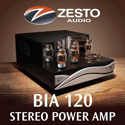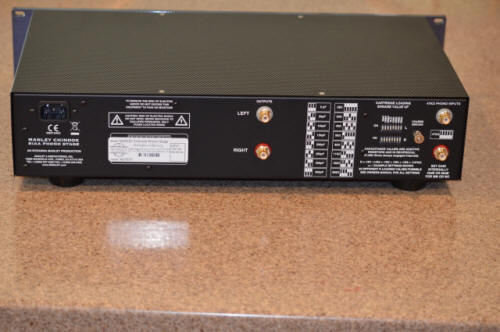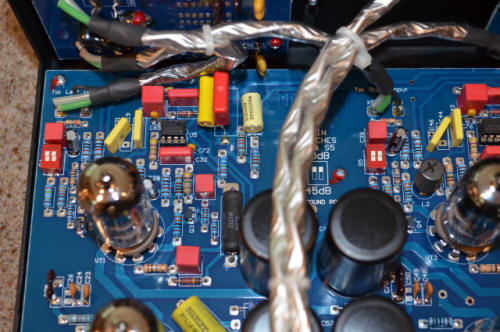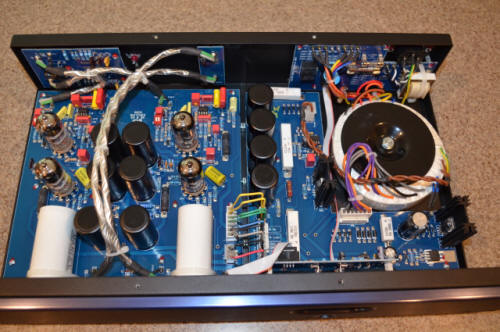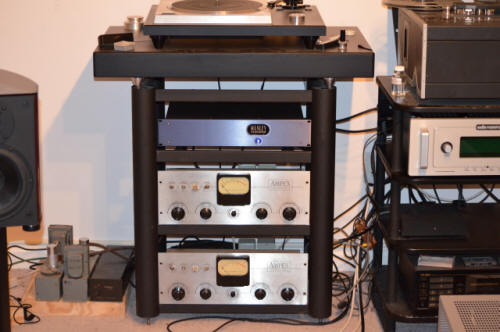|
|
You are reading the older HTML site
Positive
Feedback ISSUE 74
manley Chinook Phono Preamplifier as reviewed by Mark Pearson
After reviewing several pieces of high-end audio gear lately that arrived at my house in plain cardboard boxes, marginally adequate packing materials that weren't designed or manufactured by professionals, wrapped in layers of cellophane wrap instead of being inserted into a custom made plastic bag, and arriving sans power cord and instruction manual, it was indeed a breath of fresh analog air when the Manley Chinook showed up on my door for review. First of all, the Manley arrived in a sturdy custom made cardboard box complete with the Manley logo on the outside of the box so it doesn't look like an unmarked box of porn material was just shipped to your doorstep. I was pleasantly surprised to open the Chinook box and see a custom cut piece of foam on top with an owner's manual staring me in the face. Removing the owner's manual and lifting off the top piece of foam revealed the Chinook nestled inside of a custom fit plastic bag to protect it from the elements. And lo and behold, there was a decent power cord as well. Lifting the Chinook out of the foam insert revealed the quality of the custom cut foam that the Chinook fit into like a glove. The Chinook was designed to use either MM cartridges or MC cartridges and it has extensive capabilities for both MM and MC cartridges on the back panel.
You can set the input capacitance to seven different levels from 50pF up to 350pF. There are 32 different loading possibilities for MC cartridges (which includes the default 47k value) and I used 100 ohms which is how my Krell KPE Reference phono stage is set. The MM input impedance is fixed at 47K ohms. The MM gain is fixed at 45dB and the MC gain is fixed at 60dB. 60dB of gain is more than adequate for the majority of MC cartridges on the market. Since I was using a Dynavector XV-1s MC cartridge, I needed all of the gain I could get. To change the gain requires removing the top perforated metal cover and flipping a pair of switches so they aim towards the rear panel of the Chinook.
The quality of the sheet metal work on the Chinook is outstanding. The 8 screws that hold the perforated metal cover to the chassis are countersunk machine screws and they all fit perfectly which is not something I take for granted anymore. The four 6922 tubes used in the Chinook come installed from the factory in their sockets. The Chinook has a hefty toroid power transformer (no wimpy wall warts used here) and has extensive voltage regulation. The B+ rails, the heaters, and the control voltage rails are all regulated. There is a pair of beefy custom made coupling caps as well. Two of the 6922 tubes are used in the gain stage and the remaining pair is used in the output stage in a White Follower configuration which means it drops the output impedance to a low level (91 ohms) which allows it to drive long interconnects without rolling off the highs. When you look at the quality of the circuit board, the layout, and the quality of the parts, you instinctively know the Chinook is a high quality piece of electronics.
Oh, and the RCA jacks are very high quality and mounted to the chassis and not mounted to the main circuit board. There is one set of RCA input jacks and one pair of RCA output jacks. I strongly suspected that the Chinook used JFETs in order to increase the gain to 60dB and keep the noise as low as possible. The owner's manual hints at it, but doesn't come out and say it. I sent an email to Manley Labs and asked for some clarification on whether the Chinook uses JFETs and if there was anything else unique about the circuit that wasn't spelled out on their website or the owner's manual. EveAnna was kind enough to personally email a response to me and this is what she had to say: "Further elaborating, if you would like to describe the CHINOOK electric circuit, the input stage uses an N-Channel JFET cascoded with a 6922 (6DJ8-family) triode. This arrangement provides the best of both worlds: a low noise and high headroom amplification stage with the glorious sound that vacuum tubes provide. That then drives the passive RIAA network which then connects to another similar JFET cascode gain stage to complete the maximum 60dB of super quiet amplification. The output stage is our favorite White cathode follower configuration using another 6922's two triodes. The White Follower offers high current drive and a super-low output impedance. This circuit can drive up to 3uF of cable capacitance and can put out +22dBu into a punishing 600 Ohms. This circuit is far superior to the traditional cathode followers using a single triode that most other folks use. The CHINOOK uses all the same high quality audiophile parts that the STEELHEAD does, only we have kept cost down by containing the CHINOOK in a single chassis and eliminating all of the front panel controls." There are lots of options in the tube world when the circuit uses 6922 type tubes. I have a fairly decent stash of tubes in the 6922 family including 7308s, 6DJ8s, ECC88s, and CCa tubes. As much as I would have liked to swap in some of my tubes, I don't believe in doing that when reviewing a piece of gear. I'm going to listen to a piece of tube gear with the tubes the manufacturer shipped it with because that is how most people will listen to it. The tubes supplied by Manley are super low noise and sound damn good. The 6922 tubes shipped in the Chinook I received for review came with Electro-Harmonix (EH) 6922 tubes. The Chinook is a full-size component that fit perfectly into my VPI TNT stand.
As soon as the Manley is plugged into an outlet, a soft purple glow emanates from the front mounted push button switch. As soon as you engage the switch, the Manley logo that is centered above the power switch lights up in a soft white glow. I find this to be a classy touch and not garish in a way that I find some other gear to look. I inserted the Manley into my system which for LP consists of a Technics SP-10 MKII table in a custom machined plinth, an SME-312s arm, and a Dynavector XV-1s cartridge. I realize the XV-1s cartridge only has .3mv output which is really pushing the Chinook with 60dB of gain and I certainly wouldn't recommend a MC cartridge with less gain. The Chinook was hooked to my ARC Ref 5SE preamp and ARC Ref 75 power amp. I'm still waiting for my Nola KO speakers that I ordered to show up, so in the meantime, I'm using a pair of Wilson Benesch ARC speakers and a pair of Definitive Technology Reference subs. The reason why I wanted to review the Manley Chinook in the first place is because I heard it at Axpona 2013 and was mightily impressed. For those of you who have never attended audio shows, it's much more rare to walk into an exhibitor's room and hear great sound than it is to walk into an exhibitor's room and hear not so good sound and start looking for the door to exit the room as quickly as you can. When I walked into the room at Axpona and saw an LP spinning and heard really good sound, I immediately looked for the phono preamp to see what it was. That was the first time I laid eyes and ears on the Chinook and I filed it away mentally in hopes of getting a chance to hear it in my own system. After having lived with the Chinook for the past month, I can promise you that I wasn't disappointed. Everything in the world of high-end audio is relative in terms of pricing and the quality you receive for the money you paid. What's expensive to some is chump change to others. The Manley Chinook retails for $2,250 and for what this phono stage brings to the table (no pun intended), I personally think it's a bargain. I know of no other tube phono stage that offers all of the features of the Chinook (the build quality, the beefiness of the power supply, the quality of parts, the loading options, and the quality of the sound) at this price point. I listened to a lot of different LPs through the Chinook and I was never disappointed. In concert with the Ref 5SE and Ref 75, the Chinook throws a wide, deep, and layered soundstage that changes with every recording you play through it which is as it should be. It simply allows the size of the recording venue whether that is a live concert or a studio recording to come through. And my oh my, does the Chinook love the sound of brass instruments and lock onto them like an eager cop with a radar gun raising money for the Policeman's Ball. Tenor sax, alto sax, trumpet, flugelhorn, you name it-the Chinook just lights them up and puts them on the stage in 3D that you don't need to wear funky glasses for. And I mean this as in they sound uncannily real and not a distraction from the rest of the music. Listening to the Thelonious Monk Quartet LP Misterioso and in particular the song "Blues Five Spot," I was struck by the dynamic shadings between ppp and fff. Monk's piano sounds so real you could almost convince yourself you could reach out and touch it. Another thing the Chinook gets right is the way notes decay off into the recording space, but I have also come to the conclusion the rest of your gear has to be of sufficient quality in order to hear this attribute. When you listen to Misterioso, you should be able to hear the sound of the sticks hitting the drumheads and the echoing/resonant decay of the shell of the drums into the space of the room. Neil Young's Live at Massey Hall is a phenomenal sounding live LP and the Chinook brings it home. When Neal is playing his guitar and singing, you could swear you were at Massey Hall and hearing this recording live from a good seat. Neal's voice is spooky real sounding and the dynamic shadings and the notes that come off of his guitar just pop into the air like they would in real life. Listen to Neal's guitar playing on the song "Old Man" and I think you may understand what I'm trying to convey. Another great sounding LP that will give your system a workout is Sonny Meets Hawk! This is a 1963 recording that will knock your socks off if the rest of your system is up to it because I can tell you the Chinook is up to it. When listening to the cut "Yesterdays," my notes said the following: This is so far past digital. Sorry digital lovers, I'm just telling the truth. You can hear the breath of air blowing into the sax. The micro dynamics are off the charts. The acoustic bass plays a line that underpins the sax playing and grounds it to the center of the earth. The air around the instruments is so palpable you could cut it with a knife. On the second cut of Sonny Meets Hawk! which is "All the Things You Are," the sound of the sax, drums and piano are so real you feel like you have been transported to the studio in a time machine. The Chinook gets the sound of "air" right. When a cymbal is struck, you not only hear the sound of the drumstick hitting the cymbal, but you hear the sound waves as they cut through the air and emanate off into space. Another area the Chinook excels at is not only capturing the leading edge of a note, but also capturing the trailing edge of notes. For example, on the Myles Davis LP Nefertiti, you can hear this as the drumsticks hit the cymbals, drumheads, and rims of the shells. The sound of the Chinook is a very open and pure sound. When I look back at all of my notes that I took listening to the Chinook, a theme does emerge. The Chinook is cut from the same cloth top to bottom. The Chinook brings music alive and it sounds very pure. Those attributes are attributable to the low distortion and low noise of the circuit which help make this preamp such a pleasure to listen through. I have heard solid state phono sections that weren't this quiet. Something else I wrote early on about the Chinook was that the sound that comes out of it is made up of flesh, blood, bones, guts, and heart and soul. Some gear gives you a zombie presentation in that you only get the outline of instruments or people, and there is no flesh on the bones. In other words, there isn't much there. Because of this, recordings sound less real and less involving because so much of the character of the singers and instruments gets lost in the box. The Chinook helps bring recorded music back to life in a way that eludes lesser phono stages (and I don't mean lesser priced, I mean lesser quality phono stages regardless of price). To think that the Manley Chinook is designed and built in the U.S. at the level of quality and sophistication that it possesses and retails for $2,250 is something of a minor miracle in this day and age. I can't recommend the Chinook highly enough. Mark Pearson
Manley Chinook Phono Preamp
Manley Laboratories, Inc.
|






